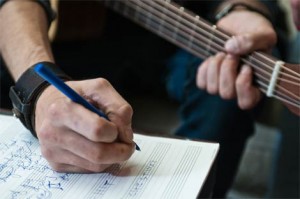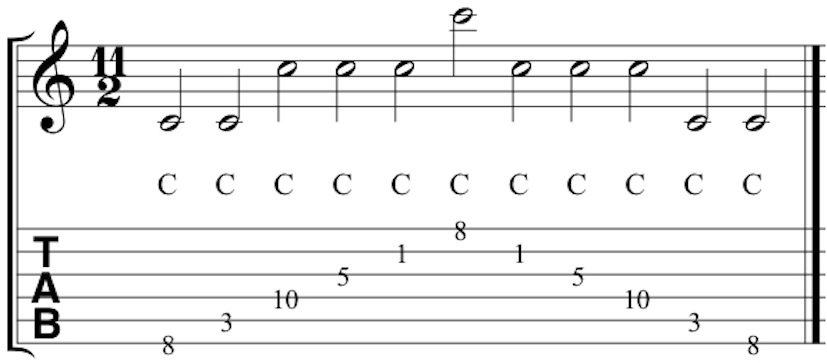Fretboard Mastery For Better Songwriting

Last week we talked about how to figure out chords to melodies in songs you’re writing. How To Write Chords To Your Melodies
I want to take this a bit further into other fields of musical knowledge related to that skill, that will help you tremendously.
Fretboard Knowledge
It helps your writing when you have a basic understanding of where the notes are on your guitar neck.
There are tons of exercises and fretboard charts out there on the internet that help guitarists learn all the notes on the guitar neck.
Let me quickly share an effective exercise with you.
This is one of the exercises that I give my lower intermediate guitar students who are interested in getting to know their guitar better.

Here’s what you do with this.
- First you play the C note on the low E string (the number 8 on the bottom line of the 6 line tablature)
- You look at your hand, familiarize yourself with that C’s position.
- Then play the C on the 3rd fret of the next string (A string)
- Go up and down, playing both these C’s up and back down, till you feel you don’t have to think about it anymore.
- Then add the C on the 10th fret of the D string.
- Now play all these 3 C notes up and down: walking from the low E string to the D string and back from the D string to the low E string.
- Then you add the next C note, and so on…
When you can comfortably play all the C notes up and down over all 6 strings, start tackling all the D notes.
The D note locations are basically 2 frets higher than all the C notes. (“Higher” means: towards the guitar body.)
Learn all the D note locations, EXACTLY the same way you practiced all the C note locations.
After you learned all the D notes.
Go back to doing all the C’s, just to get more practice in of the C’s and for memory purposes.
After that: figure out all the E notes up and down and do exactly the same as above. The E’s are 2 frets above the D’s you learned.
Then do the drill again with all the Fs. F’s are 1 fret above the E notes.
Then G notes: 2 frets above the F’s
A’s are 2 frets above the G’s
B notes are 2 frets above the A notes, which btw is also 1 fret BELOW all the C notes you learned previously.
And that’s it.
You practice this: 3 sessions of 4 minutes a day = 12-minute daily drill.
I can assure you that you will know your fretboard at least 3 times as well within 1 week time if you did not know your fretboard at all before doing this exercise.
Practicing the Sharps and Flats
Give it a week of practice, then start practicing all the C# notes (= C notes up 1 fret)
Eb notes = E notes down 1 fret
F# notes = F notes up 1 fret
Ab notes = A notes down 1 fret
Bb notes = B notes down 1 fret
The most challenging part really is learning all the C notes. From there on you can deduct everything else from there.
There are other really great fretboard exercises, but this one is a good one to start with.
Time Yourself to See Your Progress
Use a stopwatch to time yourself and try to get faster and faster.
You can tell your progress in your fretboard mastery, by how long it took you to find all the notes.
If it takes you less time to finish the exercise, that means that you didn’t have to think as long to find the notes, which means that you know your fretboard better already.
Once all the above get easier do the following exercise:
In following order and while timing yourself with a stopwatch:
- play all the C’s up and down the guitar neck,
- then without pausing, quickly move on to all the F notes,
- B’s,
- E’s,
- A’s,
- D’s,
- and G’s
Right after you played the last G note on the low E string, quickly stop the clock and write down your time.
The goal is: finishing the whole exercise in less than 40 seconds max.
Writing down your times every time you do the exercise is motivating: you see how much better you are getting.
Always Know What and Why You’re Practicing!
It’s also important to know how any exercise is going to help you within the context of your musical goals.
In this particular case, in the context of becoming a better songwriter, knowing what the notes are on the guitar neck, saves you a lot of time.
For example:
- You hear a melody in your head.
- You figure out the notes of that melody on the guitar
- You know what the names of those notes are (because of the above exercise)
- And as such, if you have the notes memorized that all major and minor chords consist of (see last week’s blog), you know what the chords are that work with the melody line.
This gives you much faster results than randomly hitting tons of chords hoping you will accidentally hit one that works with the melody you’re hearing. 🙂
THAT is why you want to have better memorization of the note locations on your instrument.
While it might be true that The Beatles, The Rolling Stones, or Jimi Hendrix wrote tons of amazing songs without knowing the note locations on their fretboard: it helps if you do.
(Moreover: nobody knows that to be for a fact that they had no idea what the name of the note was when they hit an A note, or Bb, or C# or any note for that matter on their guitars.)
Also: there are many different paths to mastery.
Having the above knowledge down helps you as a songwriter, but is not “essential”
That knowledge though does give you an extra set of tools that give you more control as a writer.
Sure you can write amazing songs without any theory knowledge or fretboard knowledge (if you have a natural inclination or you grew up in a musical family for example)…
… but you will never really know what else could have been possible with that song, what other chords could have worked, how much better the feel, vibe, and message of the song could have been emphasized, and so on.., when the chords you came up with just “happened to you”.
Become A Better In Control Channel For The Songs The Universe Sends You.
Having a thorough theoretical knowledge gives you that broad perspective over all the possibilities and colors you can pick and choose from.
Here’s an example:
Every day I work with singer-songwriters who come in with the song they wrote and want me to have a quick look at.
They are very proud of the song and want my feedback.
I listen to their performance of their song while making notes.
Then I tell them: “Great song. Now humor me for a minute and play the song with the changes I just made to your chord progression in the last minute”
And you see, as they play the new version, how they get eyes like saucers, lighting up as they are playing their song with the new chords.
You visible see them switch from “I can’t believe how good this song is that I wrote” to … “Oh woow… how did he come up with this chord progression. I didn’t know this was possible with my song”. 🙂
Moral of the story: you can never know too much. Everything you know ends up making your songs better.
This gives you a lot to work with.
In the next blog in the upcoming week: let’s take the topic of “writing chords to melodies” a bit further, with a discussion of the theory of “chords in a scale”.
Conclusion
Hit me up anytime at vreny@zotzinmusic.com if you have any questions, or if you would like to book a lesson.
These free lessons are cool, but you will never experience the progress, joy, and results that my students experience in lessons when you’re learning by yourself from blogs and videos.
That is why people take lessons: way better results and progress, much more complete information, exposed to way more creative ideas than you can get from a blog or YouTube video.
There is only so much that self-study can accomplish.
If you want to see amazing results and progress in your guitar playing, buy your first lesson here and get started ASAP.
You’ll impress your friends and loved ones in no time with your guitar playing!
Consider donating any small amount to help me keep this blog going.
Thank you for your support!


